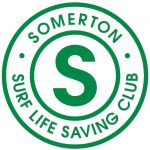The historical information provided on this website are edited extracts from a draft copy of a book soon to be published titled
“White, Green and Black – Somerton SLSC – 1960-1975: The Formative Years”.
These extracts have been provided to give you an insight into the formation of the club in the early years but are not the whole story. The book has been written by two of the clubs founding members, Tony and Robin Kidney. For the “whole story”, you can purchase a copy of the book.
INTRODUCTION
This history covers those years when the Club was ‘feeling its way’, and whether or not the Club succeeded or not depended upon the members who devoted their time in Spartan circumstances, to the Club. It is important that those who are now members, and those future members, have an understanding of what life was like, the sacrifices that were made, who was involved and know the stories of the formative years.
At the end of this period of the Club’s history, membership grew from about 15 active members in the first season, to around 150, including Nippers. That the Club membership, at the time of writing (2016), is in excess of 1,000 members, is testament to those who put in the effort when there was no certainty that the Club would survive.
At the time of writing, the Club was in its 55th year. Therefore, this history only covers less than a third of the Club’s history, albeit, probably the most important chapter in the Club’s history. There is hope that the story of the following years, when the Club moved from being a Club with a permanent home, to the force that it is today in Surf Lifesaving in South Australia, will be written by others.
This concludes this history of the Somerton Surf Lifesaving Club, from its inception in 1960 to the end of the 1974-75 season when the new Clubhouse was built.
FOUNDING MEMBERS
Robin Kidney
Robin Kidney, who founded the Club, started his lifesaving career at the newly formed West Beach Surf Lifesaving Club.
Robin left school at fourteen years of age and commenced work at the then Postmaster Generals office (PMG). He continued to work for the PMG and then Telecom when the PMG was divided into Telecom and Australia Post.
Robin has always been heavily involved in community activities. While still captain of the Somerton SLSC, he founded the Mitchell Park Australian Rules Football Club, which still continues to this day.
He also served as a member of the Army Reserve with the 10th Battalion, Royal South Australian Regiment for a number of years.
Tony Kidney
Tony, like Robin, left school at fourteen years of age and commenced work with the Australian Taxation Office (ATO).
In 1975, Tony transferred to the ATO in Canberra, where he completed his degree in accounting. He then went on to complete a law degree. Tony resigned from the ATO in 1988 and went into private practice as a solicitor. He was appointed as the Professional Standards Director of the Law Society of the Australian Capital Territory in 1995, and held this position until his retirement in 2006.
Since retirement, Tony lectures at the University of Canberra in law and also tutors at the Australian National University in the Graduate Diploma in Legal Practice.
He continued with his lifesaving activities for a number of years as a member of the Batemans Bay SLSC and Broulee Surfers SLSC.
Tony still lives in Canberra and is married and has two children and four grandchildren
Philip Lambourne
One of the founders of the Club was Philip Lambourne, who along with Robin Kidney, made the sacrifice of leaving a successful club, West Beach, because he, like Robin saw the need to provide a service to the beach going public at Somerton.
He accepted the position of vice captain at the beginning, and served with honour and competence and ably assisted with the training of the new members.
It was during the winter of 1961 that Phillip accepted a position of a cadet photographer with the Adelaide newspaper, ‘The Advertiser’. It was ironic that his first assignment was to cover the West Beach carnival at which Somerton made their debut appearance in competition. It was Phillip who took the photograph that was used for the 50th anniversary T shirt.
Through the passage of time, his job took Phillip away on many assignments which resulted in Phillip taking leave of absence. He spent many years covering the Vietnam War and moving into areas of the Middle East. His stories were always interesting to listen to and it made everyone appreciate how lucky we were.
Tragically, Phillip’s life was cut short when he died of cancer just after the Club’s 25th anniversary. If he were here today his camera would be recording every moment of the Club’s history.
